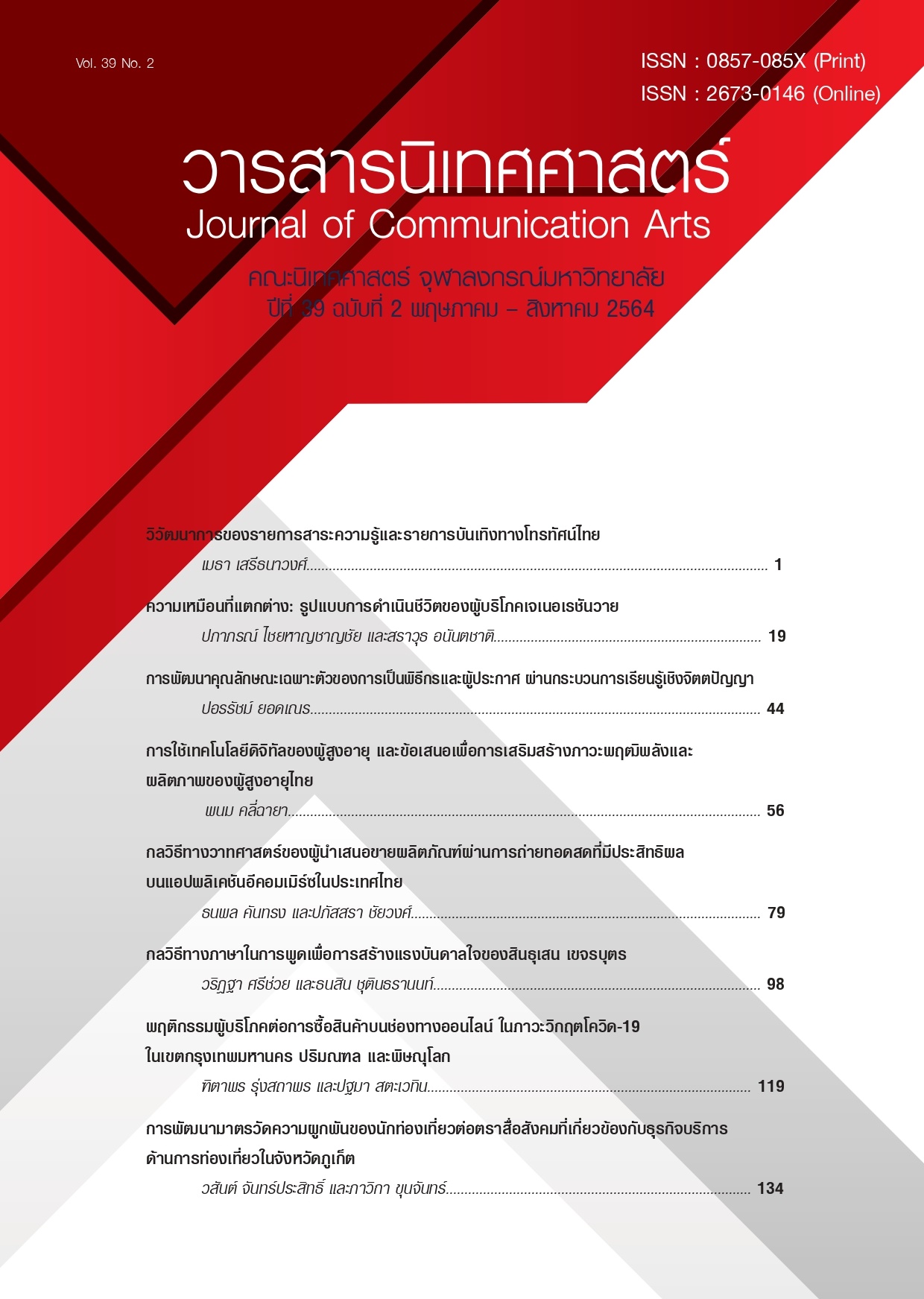การพัฒนามาตรวัดความผูกพันของนักท่องเที่ยวต่อตราสื่อสังคมที่เกี่ยวข้องกับธุรกิจบริการด้านการท่องเที่ยวในจังหวัดภูเก็ต
Main Article Content
บทคัดย่อ
การวิจัยนี้เป็นการพัฒนามาตรวัดความผูกพันของนักท่องเที่ยวต่อตราสื่อสังคมที่เกี่ยวข้องกับธุรกิจบริการด้านการท่องเที่ยวในจังหวัดภูเก็ต โดยใช้ระเบียบวิธีการวิจัยแบบผสมผสานระหว่างการวิจัยเชิงคุณภาพและการวิจัยเชิงปริมาณ ผลการวิจัยยืนยันว่า มาตรวัดความผูกพันของนักท่องเที่ยวชาวไทยและชาวยุโรปต่อตราสื่อสังคมที่เกี่ยวข้องกับธุรกิจบริการด้านการท่องเที่ยวในจังหวัดภูเก็ต ประกอบด้วย 5 องค์ประกอบ 22 ตัวชี้วัด ซึ่ง 5 องค์ประกอบของมาตรวัดฯ มีลำดับความสำคัญที่แตกต่างกันในการรับรู้ของนักท่องเที่ยวชาวไทยและชาวยุโรป ผลการวิจัยสนับสนุนสมมติฐานที่ว่า ความเกี่ยวพันที่นักท่องเที่ยวมีต่อตราสื่อสังคมฯ เป็นตัวแปรที่มีอิทธิพลทางตรงในเชิงบวกอย่างมีนัยสำคัญทางสถิติต่อความผูกพันของนักท่องเที่ยวต่อตราสื่อสังคมฯ และความผูกพันต่อตราสื่อสังคมฯ เป็นตัวแปรที่มีอิทธิพลทางตรงในเชิงบวกอย่างมีนัยสำคัญทางสถิติต่อความภักดีของนักท่องเที่ยวต่อตราสื่อสังคมฯ ผลการวิจัยยังพบว่า มาตรวัดความผูกพันของนักท่องเที่ยวต่อตราสื่อสังคมฯ ที่พัฒนาจากการวิจัยครั้งนี้สามารถนำไปใช้ได้กับทั้งนักท่องเที่ยวชาวไทยและชาวยุโรปที่มีการสร้าง เผยแพร่ข้อมูลด้านการท่องเที่ยวทางสื่อสังคมในระดับต่ำและระดับสูง นอกจากนี้ ผลการวิจัยได้นำเสนอกลยุทธ์การทำให้นักท่องเที่ยวชาวไทยและชาวยุโรปมีความผูกพันต่อตราสื่อสังคมที่เกี่ยวข้องกับธุรกิจบริการด้านการท่องเที่ยวในจังหวัดภูเก็ต ทั้งกลยุทธ์โดยตรงและโดยอ้อม อันจะนำไปสู่การทำให้นักท่องเที่ยวมีความภักดีต่อตราสื่อสังคมที่เกี่ยวข้องกับธุรกิจบริการด้านการท่องเที่ยวในจังหวัดภูเก็ต
Article Details
เอกสารอ้างอิง
กระทรวงการท่องเที่ยวและกีฬา. (2560). สรุปรายได้และค่าใช้จ่ายการท่องเที่ยวจากนักท่องเที่ยวชาวต่างชาติที่เดินทางเข้าประเทศไทย ปี 2559. วันที่เข้าถึงข้อมูล 21 สิงหาคม 2560, แหล่งที่มา http://www.mots.go.th/more_news.php?cid=438&filename=index
ธนาคารกสิกรไทย. (2559). โรงแรม ทัวร์ บูม รับกระแสการท่องเที่ยวโต. วันที่เข้าถึงข้อมูล 31 สิงหาคม 2560, แหล่งที่มา https://www.kasikornbank.com/th/business/sme/KSMEKnowledge/article/KSMEAnalysis/Pages/Hotel-Tour-Growth_Tourism-Trend.aspx
ธีรวุฒิ เอกะกุล. (2543). ระเบียบวิธีวิจัยทางพฤติกรรมศาสตร์และสังคมศาสตร์. อุบลราชธานี: สถาบันราชภัฎอุบลราชธานี.
ศูนย์วิจัยด้านตลาดการท่องเที่ยว การท่องเที่ยวแห่งประเทศไทย. (2560). เอกสารเข็มทิศฉบับที่ 2/2560 (ฉบับ Summer Destinations). วันที่เข้าถึงข้อมูล 17 มีนาคม 2560, แหล่งที่มา http://tatic.tourismthailand.org/articles/8048
ศูนย์วิจัยเศรษฐกิจและธุรกิจ ธนาคารไทยพาณิชย์ จำกัด (มหาชน). (2559). ท่องเที่ยวไทยติดปีก ฉีกกรอบตลาดเดิม. วันที่เข้าถึงข้อมูล 22 พฤศจิกายน 2560, แหล่งที่มา https://www.scbeic.com /th/detail/product/2952
ศูนย์วิจัยเศรษฐกิจและธุรกิจ ธนาคารไทยพาณิชย์ จำกัด (มหาชน). (2560). 3 กระแสแรงแห่งยุค ปรับลุคธุรกิจท่องเที่ยว. วันที่เข้าถึงข้อมูล 23 ธันวาคม 2560, แหล่งที่มา https://www.scbeic.com/th/detail/file/product/3369/eol70mpcpl/EIC_Insight_Tourism_2017_TH.pdf
สำนักงานปลัดกระทรวงการท่องเที่ยวและกีฬา (2563). สถานการณ์ด้านการท่องเที่ยว. วันที่เข้าถึงข้อมูล 30 มราคม 2563, แหล่งที่มา https://secretary.mots.go.th/policy/more_news.php?cid=32
Amaro, S., Duarte, P., & Henriques, C. (2016). Travelers’ use of social media: A clustering approach. Annals of Tourism Research, 59(C), 59–15.
Anderson, B. (1991). Imagined communities (2nd ed). London: Verso.
Bowden, J. L. (2009). The process of customer engagement: A conceptual framework. Journal of Marketing Theory and Practice, 17(1), 63-74.
Brodie, R. J., Ilić, A., Jurić, B., & Hollebeek, L. D. (2013). Consumer engagement in a virtual brand community: An exploratory analysis. Journal of Business Research, 66, 105-114.
Cabiddu, F., Carlo, M. D., & Piccoli, G. (2014). Social media affordances: Enabling customer engagement. Annals of Tourism Research, 48(C), 175 - 192.
Chung, N., & Koo, C. (2015). Telematics and Informatics. The use of social media in travel information search, 32(2015), 215–229.
Churchill, G. A. J. (1979). A paradigm for developing better measures of marketing constructs. Journal of Marketing Research, 16(February), 64-73.
Dessart, L., Veloutsou, C., & Morgan-Thomas, A. (2015). Consumer engagement in online brand communities. The Journal of Product and Brand Management, 24(1), 28-42.
Fotis, J., Buhalis, D., & Rossides, N. (2012). Social media use and impact during the holiday travel planning process. In M. Fuchs, F. Ricci, & L. Cantoni (Eds.), Information and communication technologies in tourism (pp. 13–24). Vienna, Austria: Springer.
Gretzel, U. (2012). Introduction to the section on web 2.0 and travellers’ behaviour. In M. Sigala, E. Christou, & U. Gretzel (Eds.), Social media in travel, tourism and hospitality: Theory, practice and cases (pp. 167–169). Surrey: Ashgate.
Gretzel, U., Yoo, K. H., & Purifoy, M. (2007). Online travel review study: Role & impact of online travel reviews. Retrieved April 27, 2019, from http://www.tripadvisor.co.uk/pdfs/OnlineTravelReport.pdf
Hair Jr., J. F., Anderson, R. E., Tatham, R. L., & Black, W. C. (1998). Multivariate data analysis (5th ed.). Upper Saddle River, NJ: Prentice Hall.
Harrigan, P., Evers, U., Miles, M., & Daly, T. (2017). Customer engagement with tourism social media brands. Tourism Management, 59(C), 597-609.
Hollebeek, L. D. (2011). Demystifying customer brand engagement: Exploring the loyalty nexus. Journal of Marketing Management, 27(7-8), 785-807.
Hollebeek, L. D., Glynn, M. S., & Brodie, R. J. (2014). Consumer brand engagement in social media: Conceptualization, scale development and validation. Journal of Interactive Marketing, 28(2), 149-165.
Hudson, S., Roth, M. S., Madden, T. J., & Hudson, R. (2015). The effects of social media on emotions, brand relationship quality, and word of mouth: An empirical study of music festival attendees. Tourism Management, 47, 68-76.
Ip, C., Lee, H. A., & Law, R. (2012). Profiling the users of travel websites for planning and online experience sharing. Journal of Hospitality & Tourism Research, 36(3), 418 –426.
Kaplan, A. M., & Haenlein, M. (2010). Users of the world, unite! The challenges and opportunities of social media. Business Horizons, 53(1), 61.
Kavoura, A., & Stavrianea, A. (2014). Economic and social aspects from social media’s implementation as a strategic innovative marketing tool in the tourism industry. Procedia Economics and Finance, 14, 303-312.
Kemp, S. (2017). The state of the internet in Q2 20174. Retrieved April 26, 2019, from https://wearesocial.com/special-reports/state-internet-q2-2017
Kumar, V., Aksoy, L., Donkers, B., Venkatesan, R., Wiesel, T., & Tillmanns, S. (2010). Undervalued or overvalued customers: Capturing total customer engagement value. Journal of Service Research, 13(3), 297-310.
Kuvykaité, R., & Tarute, A. (2015). A critical analysis of consumer engagement dimensionality. Kaunas, Lithuania: International Scientific Conference Economics and Management (ICEM).
Malthouse, E., & Hofacker, C. (2010). Looking back and looking forward with interactive marketing. Journal of Interactive Marketing, 24(3), 181-184.
Mollen, A., & Wilson, H. (2009). Engagement, telepresence and interactivity in online consumer experience: Reconciling scholastic and managerial perspectives. Journal of Business Research, 63, 919-925.
Munar, A. M., & Jacobsen, J. K. S. (2014). Motivations for sharing tourism experiences through social media. Tourism Management, 43, 46-54.
Parra-López, E., Gutiérrez-Taño, D., Díaz-Armas, R. J., & Bulchand-Gidumal, J. (2012). Travellers 2.0: Motivation, opportunity and ability to use social media. In M. Sigala, E. Christou, & U. Gretzel (Eds.), Social media in travel, tourism and hospitality: Theory, practice and cases (pp. 171–187). Surrey, UK: Ashgate.
Patterson, P., Yu, T., & De Ruyter, K. (2006). Understanding customer engagement in services. Advancing theory, maintaining relevance. Proceedings of ANZMAC 2006 conference, Brisbane, 4-6 December.
Pew Research Center (2013). Social networking fact sheet. Retrieved April 26, 2019, from http://www.pewinternet.org/fact-sheets/social-networking-fact-sheet/
Rothschild, M. L. (1984). Perspectives on involvement: Current problems and future directions. Advances in Consumer Research, 11(1), 216–217.
Simms, A. (2012). Online user-generated content for travel planning – Different for different kinds of trips?. e - Review of Tourism Research, 10(3), 76–85.
So, K. K. F., King, C., & Sparks, B. (2014). Customer engagement with tourism brands: Scale development and validation. Journal of Hospitality & Tourism Research, 38(3), 304-329.
Vivek, S. D., Beatty, S. E., & Morgan, R. M. (2012). Customer engagement: Exploring customer relationships beyond purchase. Journal of Marketing Theory and Practice, 20(2), 127-145.
Zaichkowsky, J. L. (1994). The personal involvement inventory: Reduction, revision, and application to advertising. Journal of Advertising, 23(4), 59-70.
Zeithaml, V., Berry, L., & Parasuraman, A. (1996). The behavioral consequences of service quality. Journal of Marketing, 60(2), 31-46.


